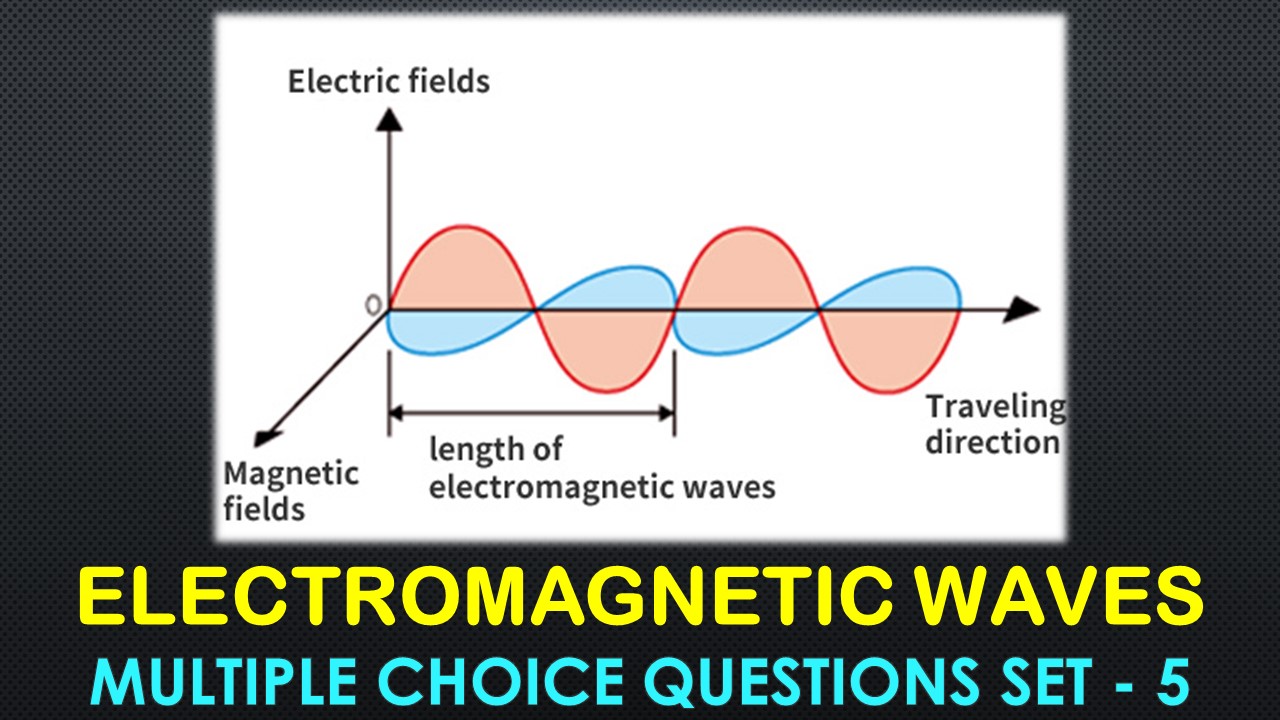CBSE Class 12 Electromagnetic Waves Multiple Choice Questions with Answers. MCQ Questions Class 12 Electromagnetic Waves with Answers Is Prepared Based on Latest Exam Pattern. Students can solve NCERT Class 12 Electromagnetic Waves MCQs with Answers to know their preparation level.
Students who are searching for NCERT MCQ Questions for Class 12 Electromagnetic Waves with Answers are compiled here to get good practice on all fundamentals. Know your preparation level on MCQ Questions for Class 12 Electromagnetic Waves with Answers. You can also verify your answers from our provided MCQ Class 12 Electromagnetic Waves with Answers. So, ace up your preparation with MCQ of Class 12 Physics Examinations.
MCQ Questions Class 12 Electromagnetic Waves with Answers - Set - 5
Question 1:
The electric field of an electromagnetic wave in free space is given by E vector= 10cos(107 t + kx)jˆ V /m , where t and x are in seconds and metres respectively. It can be inferred that
(1) the wavelength l is 188.4 m.
(2) the wave number k is 0.33 rad/m.
(3) the wave amplitude is 10 V/m.
(4) the wave is propagating along +x direction.
Which one of the following pairs of statements is correct?
(a) (3) and (4)
(b) (1) and (2)
(c) (2) and (3)
(d) (1) and (3)
Correct Answer – (D)
Question 2 :
The electric field associated with an em wave in vacuum is given by [E = i ^ 40 cos (kz – 6 × 108t)]; where E, z and t are in volt/m, meter and seconds respectively. The value of wave vector k is
(a) 2 m–1
(b) 0.5 m–1
(c) 6 m–1
(d) 3 m–1
Correct Answer – (A)
Question 3 :
Light with an energy flux of 25 × 104 W m–2 falls on a perfectly reflecting surface at normal incidence. If the surface area is 15 cm2, the average force exerted on the surface is
(a) 1.25 × 10–6 N
(b) 2.50 × 10–6 N
(c) 1.20 × 10–6 N
(d) 3.0 × 10–6 N
Correct Answer – (B)
Question 4 :
Which of the following are not electromagnetic waves?
(a) cosmic rays
(b) g-rays
(c) b-rays
(d) X-rays
Correct Answer – (C)
Question 5 :
An em wave is propagating in a medium with a velocity v- = v ^i . The instantaneous oscillating electric field of this em wave is along +y axis. Then the direction of oscillating magnetic field of the em wave will be along
(a) –z direction
(b) +z direction
(c) –y direction
(d) –x direction
Correct Answer – (B)
MCQ Questions Class 12 Electromagnetic Waves with Answers
Question 6 :
The ratio of amplitude of magnetic field to the amplitude of electric field for an electromagnetic wave propagating in vacuum is equal to
(a) the speed of light in vacuum
(b) reciprocal of speed of light in vacuum
(c) the ratio of magnetic permeability to the electric susceptibility of vacuum
(d) unity.
Correct Answer – (B)
Question 7 :
An electromagnetic wave of frequency u = 3.0 MHz passes from vacuum into a dielectric medium with relative permittivity e = 4.0. Then
(a) Wavelength is doubled and frequency becomes half.
(b) Wavelength is halved and frequency remains unchanged.
(c) Wavelength and frequency both remain unchanged.
(d) Wavelength is doubled and frequency unchanged
Correct Answer – (B)
Question 8 :
Out of the following options which one can be used to produce a propagating electromagnetic wave ?
(a) A chargeless particle
(b) An accelerating charge
(c) A charge moving at constant velocity
(d) A stationary charge
Correct Answer – (B)
Question 9 :
In an electromagnetic wave in free space the root mean square value of the electric field is Erms = 6 V m–1. The peak value of the magnetic field is
(a) 2.83 × 10–8 T
(b) 0.70 × 10–8 T
(c) 4.23 × 10–8 T
(d) 1.41 × 10–8 T
Correct Answer – (A)
Question 10 :
For a transparent medium relative permeability and permittivity, μr and er are 1.0 and 1.44 respectively. The velocity of light in this medium would be
(a) 2.5 × 108 m/s
(b) 3 × 108 m/s
(c) 2.08 × 108 m/s
(d) 4.32 × 108 m/s
Correct Answer – (A)
- NCERT Solutions Class 11 Chemistry Chapter 1 : Some Basic Concepts of Chemistry
- NCERT Solutions Class 11 Chemistry Chapter 2 : Structure Of The Atom
- NCERT Solutions Class 11 Chemistry Chapter 3 : Classification of Elements and Periodicity in Properties
- NCERT Solutions Class 11 Chemistry Chapter 4 : Chemical Bonding and Molecular Structure
- NCERT Solutions Class 11 Chemistry Chapter 5 : States of Matter
- NCERT Solutions Class 11 Chemistry Chapter 6 : Thermodynamics
- NCERT Solutions Class 11 Chemistry Chapter 7 : Equilibrium
- NCERT Solutions Class 11 Chemistry Chapter 8 : Redox Reactions
- NCERT Solutions Class 11 Chemistry Chapter 9 : Hydrogen
- NCERT Solutions Class 11 Chemistry Chapter 10 : The s-Block Elements
- NCERT Solutions Class 11 Chemistry Chapter 11 : The p-Block Elements
- NCERT Solutions Class 11 Chemistry Chapter 12 : Organic Chemistry: Some Basic Principles and Techniques
- NCERT Solutions Class 11 Chemistry Chapter 13 : Hydrocarbons
- NCERT Solutions Class 11 Chemistry Chapter 14 : Environmental Chemistry




